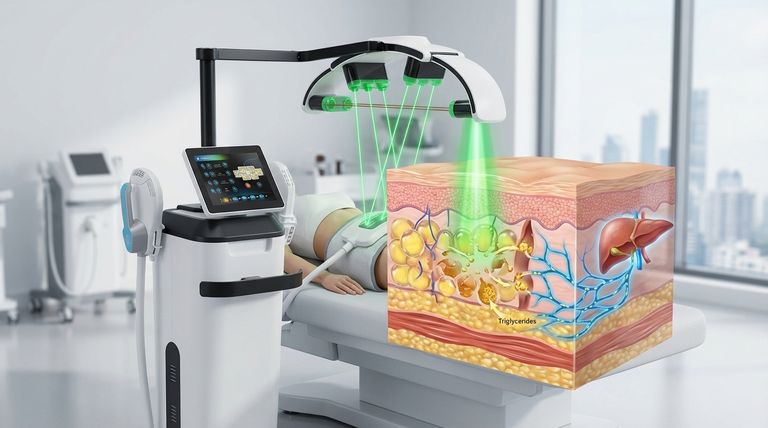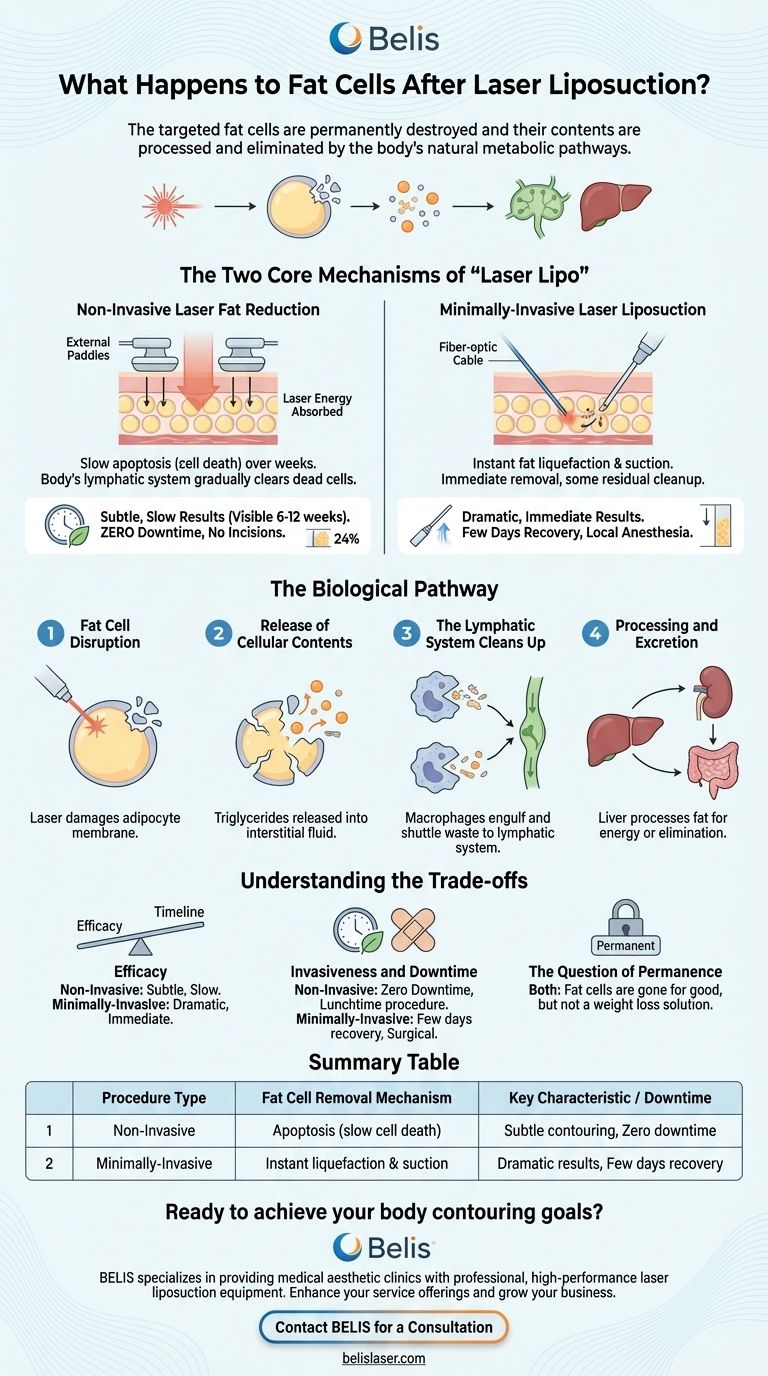In short, after laser liposuction, the targeted fat cells are permanently destroyed and their contents are processed and eliminated by the body's natural metabolic pathways. The laser energy heats and ruptures the fat cells, releasing the fat, which is then gradually cleared away by the lymphatic system over a period of several weeks.
The core concept to understand is that laser liposuction doesn't make fat cells "disappear." Instead, it triggers a natural biological process where damaged cells are identified as waste, broken down, and permanently removed by the body's own cleanup crew.

The Two Core Mechanisms of "Laser Lipo"
The term "laser lipo" is often used to describe two distinctly different procedures. Understanding which is which is critical to managing expectations.
Non-Invasive Laser Fat Reduction
This procedure involves applying laser energy through paddles placed on the surface of the skin. There are no incisions.
The laser energy penetrates the skin and is absorbed by the underlying fat cells. This heat damages the structural integrity of the cell membranes, causing them to slowly break down and die over several weeks in a process called apoptosis.
The body's lymphatic system then gradually clears away these dead cells and their contents. This is why results for non-invasive treatments appear slowly, typically becoming visible at six weeks and optimal around 12 weeks.
Minimally-Invasive Laser Liposuction
This is a surgical procedure that requires small incisions. A thin fiber-optic cable is inserted under the skin.
The laser at the tip of this fiber delivers energy directly to the fat, liquefying it instantly. A small tube, called a cannula, is then used to suction the melted fat out of the body immediately.
While the majority of the fat is removed during the procedure, some residual liquefied fat and cellular debris are left behind to be cleared by the lymphatic system, similar to the non-invasive method.
What Happens After the Laser Does Its Work? The Biological Pathway
Regardless of the method used, the body follows a specific sequence to handle the affected fat cells.
Step 1: Fat Cell Disruption
The primary function of the laser is to deliver a precise wavelength of energy that targets and damages fat cells (adipocytes) while leaving surrounding tissues like skin and muscle unharmed. This damage ruptures the cell's outer membrane.
Step 2: Release of Cellular Contents
Once the membrane is compromised, the cell releases its contents—primarily triglycerides—into the space between the cells (the interstitial fluid). The cell itself collapses and is marked as debris.
Step 3: The Lymphatic System Cleans Up
Your body's immune system responds to this cellular debris and free-floating fat. Specialized cells called macrophages engulf the dead cells and triglycerides. This waste is then shuttled into the lymphatic system, your body's extensive drainage and filtration network.
Step 4: Processing and Excretion
The lymphatic system transports this material to the liver. The liver processes these fats just as it would process fat from food you've eaten. They are then metabolized for energy or prepared for elimination from the body through natural waste processes.
Understanding the Trade-offs
Choosing the right procedure depends on a clear-eyed view of the benefits and limitations of each approach.
Efficacy and Timeline
Non-invasive procedures offer more subtle results. A single 25-minute session might destroy up to 24% of fat cells in a small, targeted area, with full results taking up to three months to appear.
Minimally-invasive laser liposuction provides more immediate and dramatic results because the bulk of the liquefied fat is physically suctioned out during the procedure.
Invasiveness and Downtime
Non-invasive treatments are true "lunchtime" procedures. They require no anesthesia, no incisions, and have zero downtime.
Minimally-invasive liposuction is still a surgical procedure. It involves local anesthesia, small incisions, and typically requires a few days of recovery and compression garments.
The Question of Permanence
In both cases, the destroyed fat cells are gone for good and do not regenerate. However, this is not a weight loss solution. The remaining fat cells in the treated area and elsewhere in your body can still expand if you gain weight in the future.
Making the Right Choice for Your Goal
Your personal goals should dictate your approach.
- If your primary focus is zero downtime and subtle contouring: A non-invasive laser treatment is the logical choice, but you must be patient for the results.
- If your primary focus is the most significant fat removal from a single session: Minimally-invasive laser liposuction will deliver more immediate and noticeable results.
- If your primary focus is overall weight loss: Neither of these procedures is appropriate. They are designed for body contouring and targeting stubborn pockets of fat, not for reducing your total body weight.
Understanding the biological process empowers you to have a more informed conversation with a qualified provider about what is achievable.
Summary Table:
| Procedure Type | Fat Cell Removal Mechanism | Key Characteristic | Downtime |
|---|---|---|---|
| Non-Invasive | Apoptosis (slow cell death) | Subtle contouring, no incisions | Zero downtime |
| Minimally-Invasive | Instant liquefaction & suction | Dramatic, immediate results | Few days recovery |
Ready to achieve your body contouring goals?
Understanding the science is the first step. The next is partnering with a trusted expert. BELIS specializes in providing medical aesthetic clinics and premium beauty salons with professional, high-performance laser liposuction equipment.
We help you deliver safe, effective, and satisfying results to your clients. Contact our experts today to learn how our technology can enhance your service offerings and grow your business.
Contact BELIS for a Consultation
Visual Guide

Related Products
- EMSlim RG Laser Body Sculpting and Slimming Machine
- EMS Body Sculpting Slimming Machine EMSlim Body Slimming Machine
- EMSlim Body Sculpting Machine EMS Body Slimming Machine
- Pico Picosecond Laser Machine for Tattoo Removal Picosure Pico Laser
- Ultrasonic Cavitation Radiofrecuency Machine for Body Slimming
People Also Ask
- How to get the best results from ultrasonic cavitation? Maximize Fat Reduction with Proper Technique
- Does EMS sculpting really work? Achieve Clinically-Proven Body Contouring
- Does ultrasonic body slimming work? A Guide to Non-Invasive Fat Reduction
- Does Emslim really work? Yes, for Sculpting Muscle, Not Just Burning Fat
- What does an EMSlim machine do? Achieve Non-Invasive Body Sculpting & Muscle Building



















